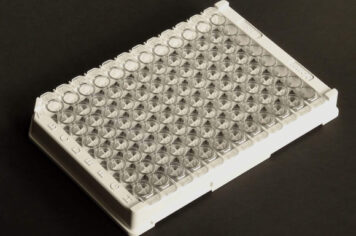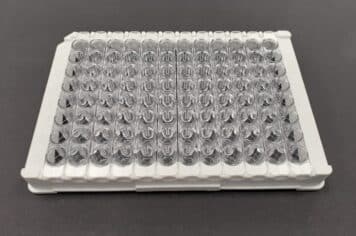No products in the cart.
Calmodulin Coated Surface is ideal for use in assay for binding specific proteins mainly with hydrophobic sites in their surface.
Calmodulin Coated Surface is a surface with physically adsorbed Calmodulin protein. The polystyrene optical features don’t change, allowing the modified surface to be used as a valid tool to carry out biological tests. The Calmodulin Ca++ binding protein is able to bind proteins mainly with hydrophobic sites on its surface.
Examples of applications for Calmodulin Coated surface
- interactions with proteins involved in glycogen metabolism
- interactions with factors involved in neurotransmission mechanism
- interactions with enzymes involved in the NAD*/NADP* phosphorylation system
Biomat Calmodulin Coated Products
Calmodulin Coated Surfaces main features
Biomat Calmodulin Coated products have the following characteristics:
- Ready to Use
- Manufactured under ISO:9001 guidelines
- All lots are tested for uniformity and reproducibility
- Certificate of Quality is released for every lot
- For Research Use Only
Also, Calmodulin Coated Products ensures:
Uniformity
The Calmodulin Coated Products show a CV% less than 5 when a monoclonal anti-calmodulin is bound on the surface in an ELISA format, using anti mouse-HRP as detector and TMB as substrate.
Storage and Stability
The Calmodulin Coated products, if unopened, are stable at 2 – 8 °C until the expiration date printed on the label. If opened, store in closed pouch with desiccant and use within the expiration date.
Calmodulin Coated Microplates Specifications
Coating
Calmodulin is coated using 200 μl/well.
Binding specificity
The binding specificity of Calmodulin Coated 96-Well Plate was evaluated towards monoclonal anti-calmodulin antibody. Click on the following link to see the results.



